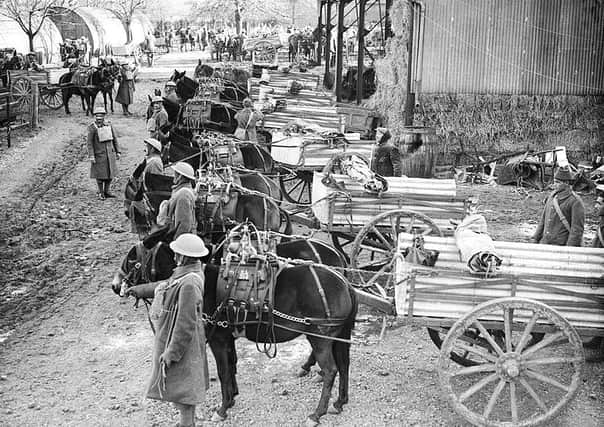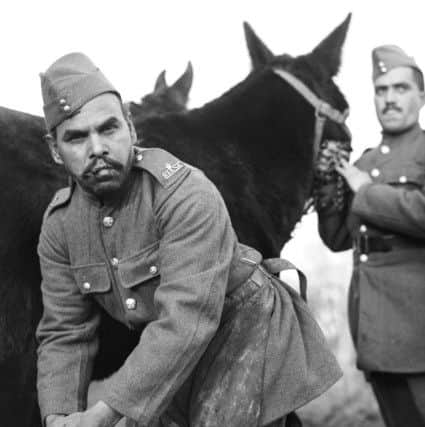Muslim soldiers who served in Scotland 'must be remembered'


Force K6, a mule transport corps with the Royal Indian Army, was sent to Scotland in 1940 to assist soldiers training in mountain warfare.
With the British Army developing a strategy to open up a new front in Norway, there were concerns that animals were needed to navigate the ground should it turn to mud, as it had so deeply on the Western Front during World War One.


Advertisement
Hide AdForce K6, which totalled 1,800 men and 2,000 animals in all, was well placed to assist given it was trained to navigate the frontier provinces of Afghanistan.
After a call for help was made by the British Army, the troops, who mostly came from modern-day Punjab in Pakistan, left in a convoy from Bombay and travelled via France to the UK.
READ MORE: The £3m scandal of the lost World War One airfield
Five companies of Force K6 were soon stationed around the Cairngorms with vast quantities of supplies including live sheep, chapatis and ghee arriving for the men by train.
Force K6 camps emerged near Aviemore and others at Ballater, Nairn and Fochabers. Men and their animals were stationed at the old Knock distillery where a mosque was set up in two Nissen huts, according to research by Hamish Johnston for the Highland Family History Society.
Thirteen men from Force K6 died during their time in Scotland as they supported infantry brigades on training in the hills.
Advertisement
Hide AdMost died from sickness and disease but a case of exposure, a shooting and a lorry crash were also reported, according to Mr Johnston.
A multi-fairth service of remembrance was held at Kingussie Cemetery today (Thursday) where nine soldiers with Force K6 are buried.
Advertisement
Hide AdNow, calls are being made for a permanent memorial in Scotland to the contribution that Muslims, Sikhs and Hindus made for Britain during both world wars.
Glasgow-based Colourful Heritage is leading the campaign for the memorial with Legion Scotland now supporting the call.
Claire Armstrong, Legion Scotland operations manager, said: “The Commonwealth answered the call with volunteers from far and wide including pre-partition India, the Caribbean and Africa, all of whom make up a vibrant part of our culture today.
“Their immense contribution cannot be understated, and we welcome the calls for permanent memorial to the soldiers of the British Indian Army in Scotland.”
The men laid to rest at Kingussie Cemetery were Ali Bahadur, 38, Bari Sher, 37, Dadan Khan, 22, Fazl Ali, 25, Khan Muhammad, 32, Khushi Muhamm, 35, Muhammad, 29, Muhammad Sadiq, 29, and Mushtaq Ahmad, 21.
Mir Zaman, 22, was buried at Aberdeen’s Allenvale Cemetery and Abdul Rakhman, 37, and Ghulam Nabi, 24, at Proncynain Cemetery in Dornoch.
Advertisement
Hide AdKaram Dad, 29, was buried at Grange Cemetery in Aberdeenshire.
Research by Mr Johnston found that nine of the 13 men died from natural causes with six cases of tuberculosis recorded.
Advertisement
Hide AdBut more troubling circumstances were reported in some cases.
Mr Johnston, in an article for the society, reported that Muhammad Sadiq was shot dead by colleague Mehr Ali Khan following a grudge, with the killer given 10 years in prison after being found guilty of culpable homicide at the High Court in Inverness.
Meanwhile, Khan Muhammed died of exposure during Operation Sphinx, a two-day exercise with 157th Brigade that sent 178 men and 243 mules and pack horses to the hills, Mr Johnston reported.
In “bitterly cold gales, rain sleet and mist” the soldiers climbed more than 3,000 ft up Gleann Enich to a bivouac at the north end of Loch Einich, according to the account.
After returning to camp at Aviemore, it was called in that one soldier was left in a “state of collapse” on the hill. Left overnight, the body of the driver was found partially clothed, likely a sign of hypothermia.
A report into the incident found that the “men were not properly fed and their clothing was inadequate for the severe wind and wet encountered,” Mr Johnston wrote.
Advertisement
Hide AdCalls for Force K6 to return to India intensified in 1943 given the need for their expertise in the Burma Campaign with the last soldier and mule leaving Scotland in January 1944.
Mr Johnston said that Indian contingent had been “underused” during its time in Britain.
Advertisement
Hide AdHowever, in his article, he added: “Perhaps more of the men returned to their homeland at the end of the war that would otherwise have been the case.
“Today the bodies of troops who died abroad are usually repatriated. For the families of the men, however, there is some corner of Scotland that is forever Pakistan.”
